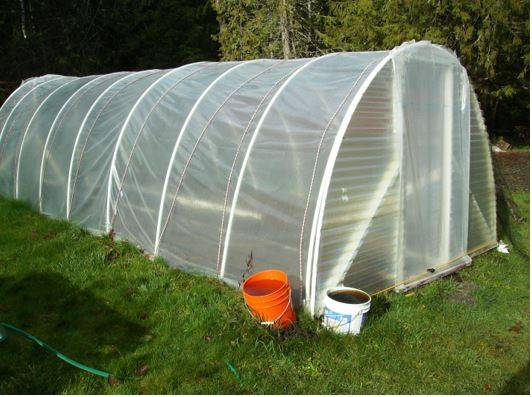A hoop house is a way to provide more control of your growing environment. A hoop house can extend the harvest season and increase the quantity and quality of your crops. Because a hoop house traps heat and warms the soil, seeds and transplants can be planted earlier. In the warmer environment, vegetables and fruits mature earlier.
A hoop house is built directly on the soil and is typically covered with 6 mil thick clear plastic. Polyethylene plastic treated with a UV inhibitor is more expensive but generally lasts 3 years compared to one year for untreated polyethylene.
The plastic is stretched over a series of arches (hoops) assembled from PVC pipe or flexible tubing, joined by pipes that run the length of the structure (each side and top center). Each end of the hoop house is framed-in to accommodate a removable door. The door should be a sturdy frame covered with plastic or a purchased exterior door.
Check second-hand building material stores for used exterior doors. Make sure the door opening is wide enough to handle your largest tool such as a wheelbarrow.
Make or purchase a screen door to provide ample ventilation while keeping animals out of the hoop house.
Some hoop house designs have sides that can be rolled up. Although this provides maximum ventilation it also exposes plants to insect and animal pests, wind and rain.
Hoop houses are different from greenhouses which tend to be more permanent, more costly, can have auxiliary heating and have a rock, wood or concrete floor. They differ from hothouses/cold frames which are usually smaller structures used to germinate seeds and/or harden off new plants prior to transplant.
Protect your hoop house from wind gusts by burying each side-length of the plastic covering in a 1-foot deep trench. Pressure-treated 2-by-4s can be used along each side at ground level to tie together the arches.
Additional stabilization can be achieved by building end benches, burying the legs of the bench 2-3 feet deep and attaching the back of the bench to the door frame or by using rebar to stabilize the timber foundation.
Without stabilization the time and money you invest in a hoop house may “take flight” or be severely damaged by strong winds.
Benches and raised beds in the hoop house create a more convenient height for your plants and for you. Elevated beds reduce the amount of stooping and back stress during maintenance and harvest. Multi-level benches increase the amount of growing space and create “more-sun/less-sun” levels to satisfy the needs of specific plants.
The controlled environment of a hoop house can decrease water evaporation and protect plants from wind damage. If too much sun becomes a problem, cover all or a portion of the hoop house plastic with shade-cloth or row covers. Providing shade to cool weather vegetables can slow their maturation and lengthen the harvest period.
Hoop houses are an inexpensive way to extend your growing season. If they seem right for you, give them a try!
Judy English is a certified WSU Clallam County Master Gardener.


